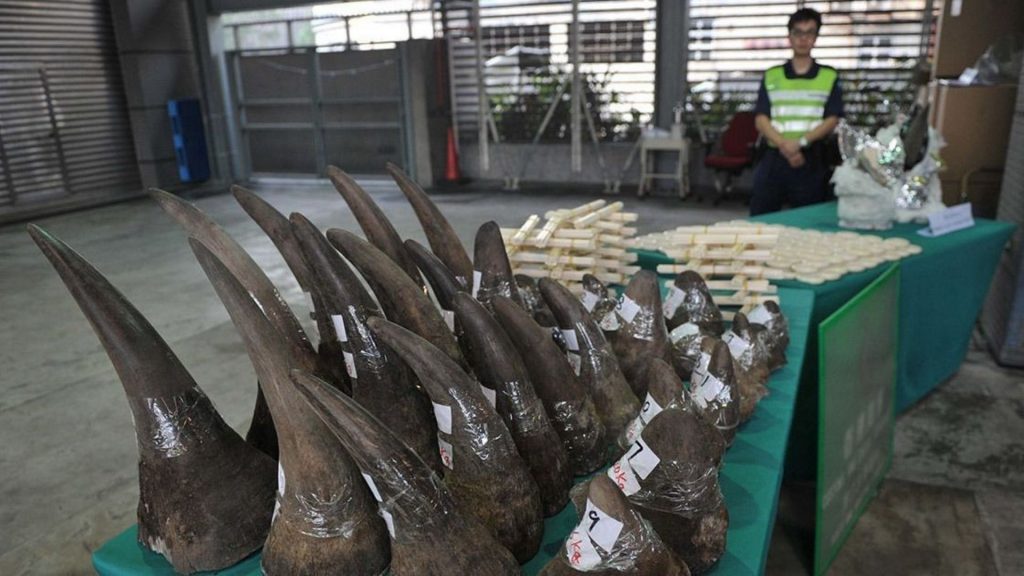The demand for illegally traded wildlife products is manifold. Different groups of consumers in different countries and geographical regions require different products for a variety of uses. We will discuss different high-value species and their hotspots, including rhinos, elephants, pangolins, and big cats.
Illegally Traded Wildlife Products: Selected High-Value Species And Hotspots In Illegal Wildlife Trade
Hundreds of millions of plants and animals are captured or harvested from the wild each year and sold as food, pets, ornamental plants, leather, tourist curios, and medicine.
While much of this trade is legal and does not harm wild populations, an alarmingly large portion is illegal and threatens the survival of many endangered species. Overexploitation is the second-largest direct threat to many species after habitat loss, so WWF prioritizes illegal and unsustainable wildlife trade.
Rhinos – Carrier Of The Rare Horn
The demand for rhino horn is driving poaching with devastating effect for the few individuals left of the few species surviving from this once numerous, widespread and cosmopolitan clade of pachyderms.
Around 80% of the world rhino population is found in South Africa. South Africa is also one of the homes of the “white rhino”, which is the largest extant species of rhinoceros. Within the white rhino population, two genetically different subspecies exist: The northern white rhino and the southern white rhino, which are found in two different regions in Africa. Let’s quickly discuss them individually.
Northern White Rhino: As of March 2018, there are only two rhinos of the northern white rhino left, both of which are female. They live in the Ol Pejeta Conservancy in Kenya and are protected round-the-clock by armed guards. Their near extinction is due to decades of rampant poaching for rhino horn.
Southern White Rhino: As for the southern white rhino, this species exists in just four countries: South Africa, Namibia, Zimbabwe, and Kenya. Southern white rhinos were thought to be extinct in the late 19th century, but in 1895 a small population of fewer than 100 individuals was discovered in Kwazulu-Natal, South Africa. After more than a century of protection and management, they are now classified as “Near Threatened” only and around 18,000 animals exist in protected areas and private game reserves. They are the only of the five rhino species that are not endangered.
According to information provided by the South African government, 16 traffickers and 502 poachers were arrested in 2017. Over the years, the anti-poaching efforts have significantly increased and the number of Rhinos that were poached each year decreased: 1,215 in 2014; 1,028 in 2017; and 769 in 2018. In April 2020, only five Rhinos were poached in Kruger National Park, located in northeastern South Africa, compared to 46 in April 2019. China, despite a national restriction on rhino horn, accounted for about 80% of the seizures of illegal rhino horns in Asia over the last decade.
In addition to the anti-poaching efforts, the effects of the Covid-19 pandemic has had its effect: The lockdown of borders, the impeded international trade, and the closure of parks for the public have contributed to the reduction of poaching in South Africa.
Elephants – The World’s Predominant Source For Ivory
The United Republic of Tanzania is one of the major hotspots for the illegal poaching and trading of elephant products. Between 1998 and 2014, 87 tons of ivory seized globally originated from Tanzania, making it the most important African country for the global supply of ivory.
Tanzania has seen a massive poaching of elephants in recent years to provide supply for the ever-growing ivory market fueled by the demand in Asian countries. In 2015, it was reported that the elephant population decreased by around 60% in five years, which accounts for the loss of 60,000 elephants.
To encounter the massive poaching of elephants, the Tanzanian government has responded with increased anti-poaching efforts and initiated an anti-poaching task force. Since 2019, the number of poached elephants is decreasing in Tanzania, and, according to the government, poaching and ivory smuggling respectively were slowed down by arresting 2,300 poachers and many of the top wildlife traffickers. Among others, a 66-year-old Chinese woman, Ms. Yang, also known as Ivory Queen, was arrested. She is accused of smuggling ivory worth $2.5 million from Tanzania to Asian countries. However, and despite the efforts of the Tanzanian government, twelve elephants were poached from September to November 2020 alone.
Another African elephant hotspot is Uganda, which has a very rich biodiversity and a diverse flora and fauna. Uganda is home to many iconic species, including the Gorilla, the African Elephant, and many species of reptiles and precious birds. During the heights of the Covid-19 pandemic, wildlife poaching in Uganda has doubled compared to the previous year.
With respect to Asian countries, Myanmar is home to the second-largest population of elephants. With China just across the border, Myanmar is a premier Asian country of origin for ivory and elephant skins. Following reports from conversation officers, poachers skin their prey on the spot after poaching it with a poisoned arrow.
With the recent coup d’état in Myanmar in early 2021, and the ongoing internal conflict and political crisis in that country, some experts say that illegal wildlife trade and the poaching of elephants could increase significantly over the next few years.
Pangolins – The World’s Most Trafficked Animal
Pangolins, sometimes known as scaly anteaters, are mammals that are mainly found in Asia and in sub-Saharan Africa. Pangolins are threatened by poaching for their meat and scales, which are used in traditional Chinese medicine, and heavy deforestation of their natural habitats. In fact, pangolins are the most trafficked mammals in the world. As of January 2020, there are eight species of pangolin whose conservation status is listed in the threatened tier.
The Asian demand for pangolin, driven by countries such as China and Vietnam, fuels the poaching and trafficking of this animal. Pangolins are in high demand for traditional Chinese and Vietnamese medicine, because their scales are believed to have medicinal properties. Pangolin meat is also considered a delicacy.
It is estimated that 100,000 pangolins are being trafficked to China and Vietnam each year, adding up to over one million over the past decade. This significant quantity makes pangolins the most trafficked animal in the world.
The intense poaching of pangolins, coupled with deforestation, has led to a large decrease in the numbers of this animal. Some species have even become commercially extinct in certain ranges as a result of overhunting. That is why all pangolin species are currently listed under Appendix I of CITES which prohibits international trade, except when the product is intended for non-commercial purposes and a permit has been granted.
China had been the main destination country for pangolins until 2018, when it was reportedly surpassed by Vietnam. In 2019, Vietnam was reported to have seized the largest volumes of pangolin scales, surpassing Nigeria that year.
Pangolins are also hunted and eaten in Ghana and are one of the more popular types of bushmeat, while local healers use the pangolin as a source of traditional medicine.
In the past decade, numerous seizures of illegally trafficked pangolin and pangolin meat have taken place in Asia. In one such incident in April 2013, 10,000 kilo of pangolin meat were seized from a Chinese vessel that ran aground in the Philippines. In another case in August 2016, an Indonesian man was arrested after police raided his home and found over 650 pangolins in freezers on his property. The same threat is reported in Nigeria, where the animal is on the verge of extinction due to overexploitation. The overexploitation comes from hunting pangolins for game meat and the reduction of their forest habitats due to deforestation caused by timber harvesting.
Tigers And Big Cats For Domestication And Traditional Chinese Medicine
The species of cats, or Felidae, how cats are called scientifically, are essentially a family of mammals. Particularly popular and most relevant from a wildlife trade perspective are the so-called “big cats” – A term typically used to refer to any of the five living members of the genus Panthera, namely the tiger, lion, jaguar, leopard, and snow leopard, as well as the non-pantherine cheetah and cougar, and sometimes the clouded leopard.
The tiger is not only the largest cat species, but also a particular iconic one among the big cats. The tiger once ranged widely from the Eastern Anatolia Region in the west to the Amur River basin in the east, and in the south from the foothills of the Himalayas to Bali in the Sunda Islands.
Since the early 20th century, tiger populations have lost at least 93% of their historic range and have been extirpated from Western and Central Asia, the islands of Java and Bali, and in large areas of Southeast and South Asia and China. Today, the tiger’s range is fragmented, stretching from Siberian temperate forests to subtropical and tropical forests on the Indian subcontinent, Indochina and Sumatra.
As of 2015, the global wild tiger population was estimated to number between 3,062 and 3,948 mature individuals, with most of the populations living in small isolated pockets. Major reasons for population decline are habitat destruction, habitat fragmentation, and poaching. Tigers are also victims of human–wildlife conflict, particularly in range countries with a high human population density.
India currently hosts the largest tiger population and most illegally traded tigers as well as tiger products originate from India. In recent years, however, countries such as Nepal, Thailand, Indonesia, and Vietnam have become increasingly important actors in illicit trade relating to tigers.
At the same time, the demand for tiger products has significantly increased, especially in China. Thailand and Vietnam are also among the frequent destination countries of illegal tiger products. Tigers themselves are frequently kept as exotic pets, for status, and for generating profits with them. Tiger bones are used in medicines and wine, and their skin is used for decorative purposes.
Since 1987, international trade in wild tigers and their items was banned by CITES. In 2007, CITES also banned the trading of tigers bred in captivity. However, there are yet frequent seizures of tigers and tiger products. Over the last decade, there have been 463 seizures of tigers worldwide, including countries such as China, Indonesia, Malaysia, Thai, and Vietnam.
Ever since the tiger population is on the decline, and tigers are more and more complicated to acquire, poachers and wildlife traffickers increasingly focus on other big cats, such as lions. Even though commercial trading of wild African lions and their products is prohibited under CITES, the number of wild African lions has decreased by almost 50% since 1993, now counting less than 20,000 individuals. Most illegally traded wild lions originate from Tanzania or Mozambique. According to seizure records, Mozambique was involved in 50% of seizures relating to lions and lion products since 2010 – Most of which were intended to be shipped to China and Vietnam.
Notably, only the commercialization and trading of wild lions is currently prohibited under CITES, whereas lions bred in captivity might be used for commercial purposes. Countries such as South Africa, where lions are bred commercially. There are currently about 350 facilities in South Africa housing between 8,000 and 12,000 captive lions, according to Panthera, a nonprofit organization focused on wild cat conservation.
Previous reports showed that the lions often live in crowded, dirty conditions. Young lions could be used for tourist attractions like petting cubs or walking with adolescents, and some farms practiced “speed breeding” where cubs are removed from their mothers after just days so that the adult female can breed again. When lions get older, farms either use them for further breeding, or sell them to hunting facilities. In “canned” hunts, the lion is kept in an enclosure for trophy hunters, who can then keep the heads and skins of the animals. The lions’ bones could then be exported.
According to a National Geographic report from 2019, the legal sale of lion bones has spurred more demand. Captive lions bred for the bone trade are often kept in especially poor conditions because owners do not care what the animals look like, unlike lions bred for tourist attractions, where appearances matter more. The growing demand may also have encouraged poachers to kill more wild lions.
However, most recent developments in South Africa suggest a policy change. In May 2021, South Africa’s Department of Forestry, Fisheries and the Environment took steps toward ending the country’s captive lion-breeding industry, beginning by stopping new permits for new captive lion facilities, and revoking current permits.
Final Thoughts
Wildlife trade is not always a problem, and the majority of wildlife trade is legal. However, it has the potential to be extremely harmful. Species populations on Earth declined by 40% on average between 1970 and 2000, and wildlife trade is the second-largest direct threat to species survival, after habitat destruction.
The most obvious issue with wildlife trade is that it can lead to overexploitation to the point where a species’ survival is threatened. Historically, such overexploitation has resulted in the extinction or near-extinction of species, and as human populations have grown, so has demand for wildlife.





